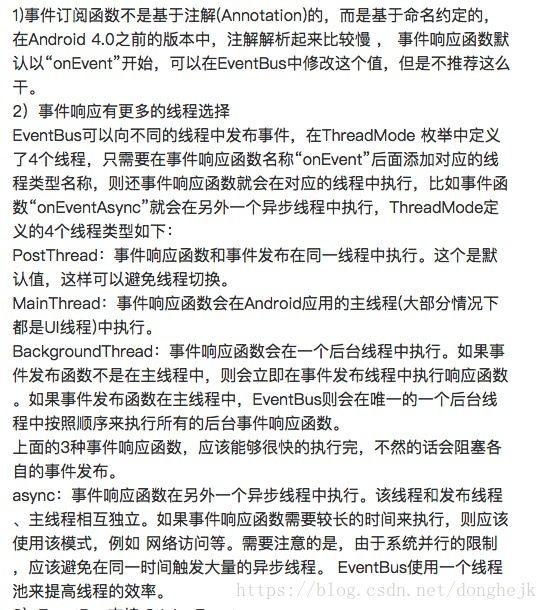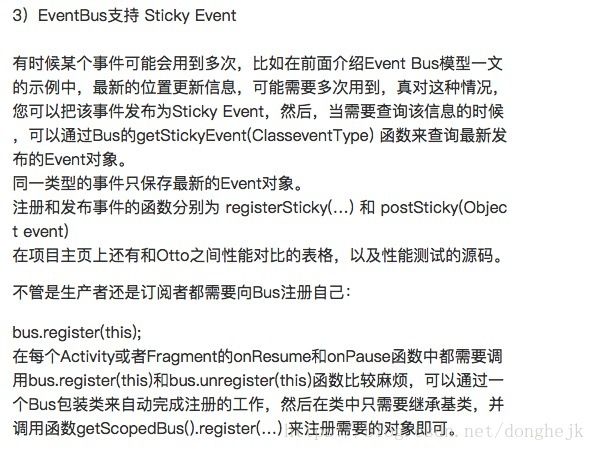EventBus底层实现原理
2种思路去读EventBus源码
1.注册 EventBus.getDefault().register(this);
2.发送消息EventBus.getDefault().post();
根据1追到了findSubscriberMethodsWithReflection 根据反射查找订阅者,代码如下里面的内容不解释了,返回的是一个订阅方法的集合。
private ListfindSubscriberMethodsWithReflection(Class subscriberClass) { List subscriberMethods = new ArrayList (); Class clazz = subscriberClass; HashSet eventTypesFound = new HashSet (); StringBuilder methodKeyBuilder = new StringBuilder(); while (clazz != null) { String name = clazz.getName(); if (name.startsWith("java.") || name.startsWith("javax.") || name.startsWith("android.")) { // Skip system classes, this just degrades performance break; } // Starting with EventBus 2.2 we enforced methods to be public (might change with annotations again) Method[] methods = clazz.getDeclaredMethods(); for (Method method : methods) { int modifiers = method.getModifiers(); if ((modifiers & Modifier.PUBLIC) != 0 && (modifiers & MODIFIERS_IGNORE) == 0) { Class[] parameterTypes = method.getParameterTypes(); if (parameterTypes.length == 1) { Subscribe subscribeAnnotation = method.getAnnotation(Subscribe.class); if (subscribeAnnotation != null) { String methodName = method.getName(); Class eventType = parameterTypes[0]; methodKeyBuilder.setLength(0); methodKeyBuilder.append(methodName); methodKeyBuilder.append('>').append(eventType.getName()); String methodKey = methodKeyBuilder.toString(); if (eventTypesFound.add(methodKey)) { // Only add if not already found in a sub class ThreadMode threadMode = subscribeAnnotation.threadMode(); subscriberMethods.add(new SubscriberMethod(method, eventType, threadMode, subscribeAnnotation.priority(), subscribeAnnotation.sticky())); } } } else if (strictMethodVerification) { if (method.isAnnotationPresent(Subscribe.class)) { String methodName = name + "." + method.getName(); throw new EventBusException("@Subscribe method " + methodName + "must have exactly 1 parameter but has " + parameterTypes.length); } } } else if (strictMethodVerification) { if (method.isAnnotationPresent(Subscribe.class)) { String methodName = name + "." + method.getName(); throw new EventBusException(methodName + " is a illegal @Subscribe method: must be public, non-static, and non-abstract"); } } } clazz = clazz.getSuperclass(); } return subscriberMethods; }
然后看调用这个方法的地方
public void register(Object subscriber) {
Class subscriberClass = subscriber.getClass();
// @Subscribe in anonymous classes is invisible to annotation processing, always fall back to reflection
boolean forceReflection = subscriberClass.isAnonymousClass();
List subscriberMethods =
subscriberMethodFinder.findSubscriberMethods(subscriberClass, forceReflection);
for (SubscriberMethod subscriberMethod : subscriberMethods) {
subscribe(subscriber, subscriberMethod);
}
}
接下来咱们继续查看 subscribe(subscriber, subscriberMethod);,如下
划线部分核心代码,到此为止EventBus.getDefault().register(this);大概干了一这样一件事情
通过反射得到观察者(订阅者)的方法,事件和所在的线程
然后将这些参数组装后放入Map中,其中key为事件类型
// Must be called in synchronized block
private void subscribe(Object subscriber, SubscriberMethod subscriberMethod) {
Class eventType = subscriberMethod.eventType;
CopyOnWriteArrayList subscriptions = subscriptionsByEventType.get(eventType);
Subscription newSubscription = new Subscription(subscriber, subscriberMethod);
if (subscriptions == null) {
subscriptions = new CopyOnWriteArrayList();
subscriptionsByEventType.put(eventType, subscriptions);
} else {
if (subscriptions.contains(newSubscription)) {
throw new EventBusException("Subscriber " + subscriber.getClass() + " already registered to event "
+ eventType);
}
}
// Starting with EventBus 2.2 we enforced methods to be public (might change with annotations again)
// subscriberMethod.method.setAccessible(true);
// Got to synchronize to avoid shifted positions when adding/removing concurrently
synchronized (subscriptions) {
int size = subscriptions.size();
for (int i = 0; i <= size; i++) {
if (i == size || subscriberMethod.priority > subscriptions.get(i).subscriberMethod.priority) {
subscriptions.add(i, newSubscription);
break;
}
}
}
List> subscribedEvents = typesBySubscriber.get(subscriber);
if (subscribedEvents == null) {
subscribedEvents = new ArrayList>();
typesBySubscriber.put(subscriber, subscribedEvents);
}
subscribedEvents.add(eventType);
if (subscriberMethod.sticky) {
if (eventInheritance) {
// Existing sticky events of all subclasses of eventType have to be considered.
// Note: Iterating over all events may be inefficient with lots of sticky events,
// thus data structure should be changed to allow a more efficient lookup
// (e.g. an additional map storing sub classes of super classes: Class -> List).
Set, Object>> entries = stickyEvents.entrySet();
for (Map.Entry, Object> entry : entries) {
Class candidateEventType = entry.getKey();
if (eventType.isAssignableFrom(candidateEventType)) {
Object stickyEvent = entry.getValue();
checkPostStickyEventToSubscription(newSubscription, stickyEvent);
}
}
} else {
Object stickyEvent = stickyEvents.get(eventType);
checkPostStickyEventToSubscription(newSubscription, stickyEvent);
}
}
}
-----------------------------------------------------------------------------------------------------------------------------
接下来看一下发送消息是怎么实现的
/** Posts the given event to the event bus. */
public void post(Object event) {
PostingThreadState postingState = currentPostingThreadState.get();
List
接着看画线部分方法,然后此方法中找到调用的postSingleEventForEventType(Object event, PostingThreadState postingState, Class eventClass)方法。划线部分是核心代码,头一个划线部分是从map中根据发送事件类型得到的一个类。这个类存储的是订阅的方法,所在的线程,不出意外的话下面应该用的是反射调用订阅的方法。拭目以待
private boolean postSingleEventForEventType(Object event, PostingThreadState postingState, Class eventClass) {
CopyOnWriteArrayList subscriptions;
synchronized (this) {
subscriptions = subscriptionsByEventType.get(eventClass);
}
if (subscriptions != null && !subscriptions.isEmpty()) {
for (Subscription subscription : subscriptions) {
postingState.event = event;
postingState.subscription = subscription;
boolean aborted = false;
try {
postToSubscription(subscription, event, postingState.isMainThread);
aborted = postingState.canceled;
} finally {
postingState.event = null;
postingState.subscription = null;
postingState.canceled = false;
}
if (aborted) {
break;
}
}
return true;
}
return false;
}
接下来咱们看一下第二个划线部分的代码。里面基本全是反射
/**
*subscription 里面存储的是要调用方法的名字等信息
*event 此事件
*isMainThread boolean 当前发送消息线程是不是UI主线程
*/
private void postToSubscription(Subscription subscription, Object event, boolean。isMainThread) {
switch (subscription.subscriberMethod.threadMode) { //当时订阅方法所在的线程
case PostThread: //非主线程
invokeSubscriber(subscription, event);
break;
case MainThread: //ui主线程
if (isMainThread) { //在主线程直接更新
invokeSubscriber(subscription, event);
} else { //通过handler发送消息,防止在自线程中更新UI的误操作
mainThreadPoster.enqueue(subscription, event);
}
break;
case BackgroundThread:
if (isMainThread) { //主线程创建runable丢入线程池
backgroundPoster.enqueue(subscription, event);
} else { //直接调用
invokeSubscriber(subscription, event);
}
break;
case Async: //直接丢入线程池
asyncPoster.enqueue(subscription, event);
break;
default:
throw new IllegalStateException("Unknown thread mode: " + subscription.subscriberMethod.threadMode);
}
}

